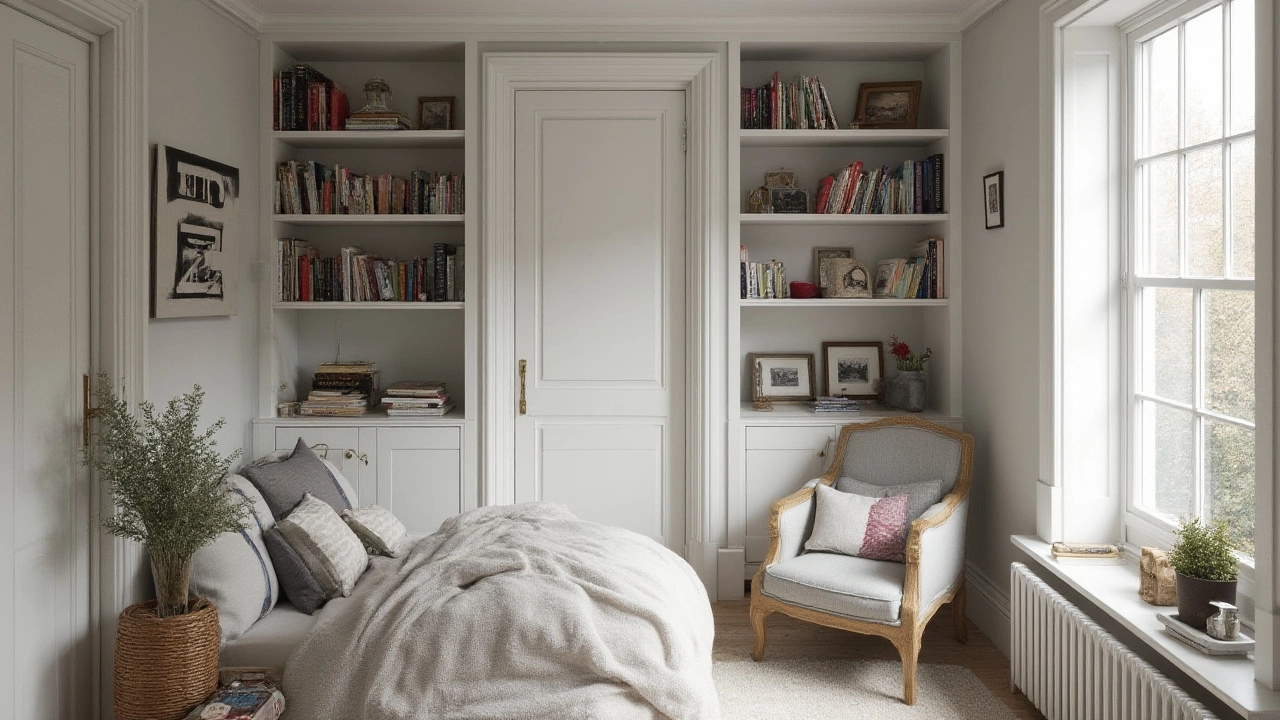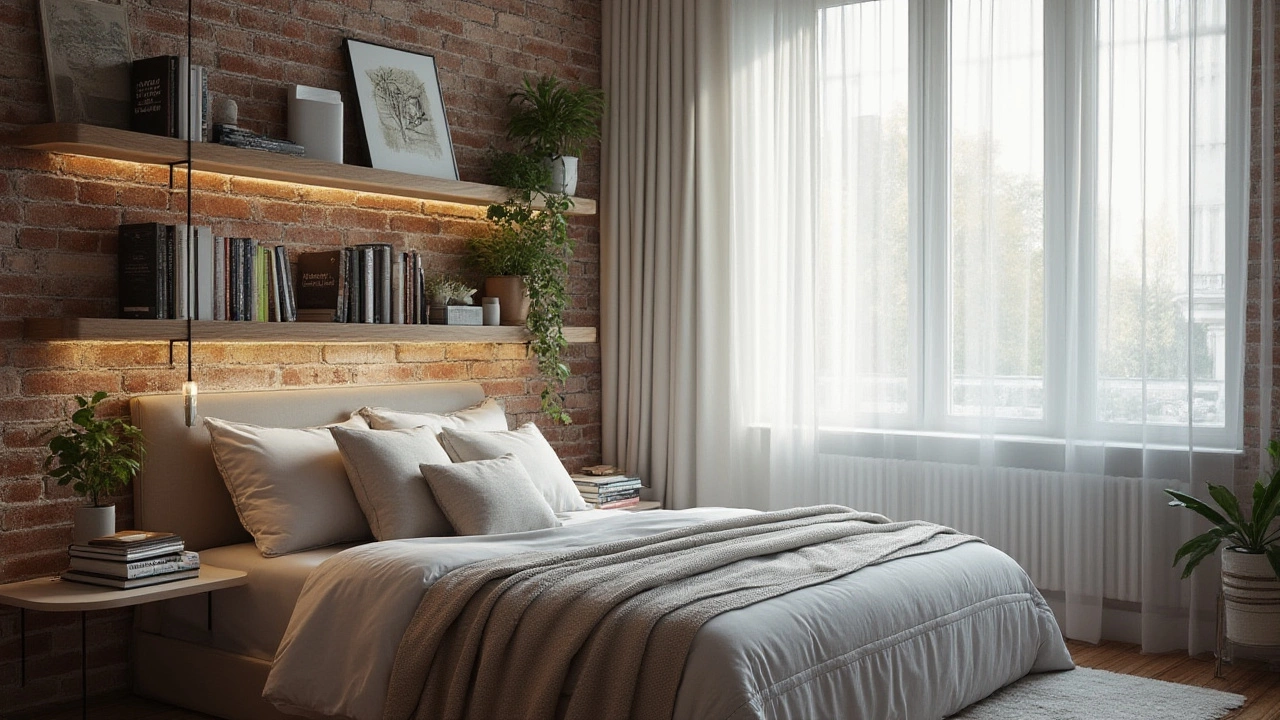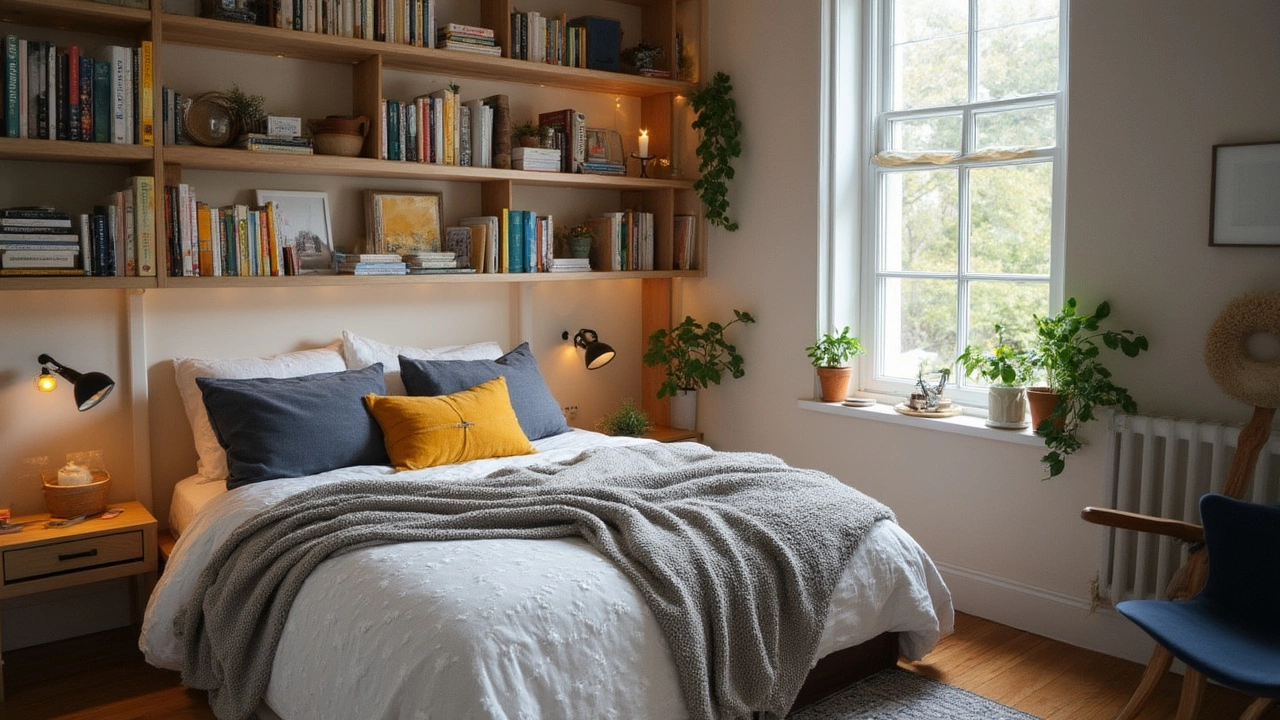Ever tiptoed through your bedroom at night, only to kick a loose Harry Potter or a tower of recipe books? Yeah, I’ve done that more times than I want to admit—especially after Elara finishes her bedtime reading marathons. The simple truth is, a small bedroom doesn’t leave you with a lot of options for extra pieces. Still, refusing to house a bookcase in your sanctuary just leads to cluttered shelves, wobbly piles, and that constant sense you’re one bedtime story away from a paperback avalanche. But you don’t have to pick between chaos and a cramped layout. There are smarter, creative ways to fit a bookcase even in the tiniest bedroom—and it’s mostly about spotting underused space and thinking vertical.
Understanding the Space: Measuring and Planning
Kicking off with solid measurements beats the shapeless guesswork every time. Grab a tape measure and jot down the length, width, and height of your room. Measure the floor area, but don’t miss corners and wall spaces that stay empty because ‘that’s where the lamp goes’ or ‘the door swings open there.’ If you’ve got a classic box-shaped bedroom, take a closer look at left and right of the bed, behind the door, and especially above any existing furniture—these are the forgotten goldmines for storage.
Some people shy away from bookcases in small bedrooms thinking there’s simply not enough floor room. But stats from home improvement surveys in 2023 showed that nearly 80% of small-space residents who used vertical shelving or over-door storage managed to reduce floor clutter by up to 60%. That’s huge! Knowing a bookcase doesn’t have to eat up precious walking space opens your mind to what’s possible. Ceiling height is your friend here—many modern bookcases run slim and tall rather than chunky and low.
Next: think about what you’re storing. Not all books are created equal. Elara’s paperbacks need less room than Milo’s pet guides or my heavy hardbacks about mid-century furniture. List what you intend the bookcase to hold; this will help pick the right depth and shelf spacing. Consider possible dual-use goals too: do you want your bookcase to double as a nightstand or room divider? Write it out. The more specific you get about your needs, the better the bookcase will serve you.
Trust me, a bit of pre-planning saves more time than you’d guess. Drawing out your bedroom’s layout (even just sketching boxes on paper or using a free online tool) gives you a bird’s-eye view. Try plugging in the sizes of different bookcases and see which placements leave enough room for basics like opening drawers, swinging open that closet, or letting Luna chase her tail without triggering a shelf collapse.
Avoid the pitfall of blocking natural light or air flow. Placing a bookcase in front of a window can seem tempting, but sunlight bleaches book covers and blocks your view—even Milo hates when his sun patch disappears. Instead, think about those shady wall corners that never get much use.
Best Areas to Place a Bookcase in a Small Bedroom
Here’s the million-dollar question: just where the heck should the bookcase go? It often depends on the shape of your room, existing furniture, and just how much you rely on the space for things other than sleeping and reading (remote work, hobbies, yoga sessions with a curious cat, you name it). Some spots shine brighter than others for keeping things handy, without feeling squeezed. Here are the bestseller bookcase spots for small bedrooms, based on real-life trial and error (and a few painful stubbed toes):
- Beside the Bed: This is a classic for good reason. A slim, vertical bookcase doubles as a nightstand and keeps books within arm’s reach. You save floor space with a narrow, tall unit—some brands make 8-10 inch deep bookcases that are surprisingly sturdy.
- Behind or Over the Bed: Floating shelves above the headboard can act as mini bookcases. Larger units with cubbies fit snugly and add a modern, custom look. Just be sure to anchor them well—nobody wants a hardback crashing down at 2AM.
- Corner Bookcases: Don’t underestimate the power of a good corner. L-shaped or triangular shelving makes excellent use of awkward angles. Many stores offer corner-specific bookcases now; you can also DIY with some creativity and a weekend free.
- Under Windows: Got a low window? Use a short bookcase along the wall. You won’t block the view or daylight, and you get bonus storage below the sill.
- Behind the Door: This gets overlooked, but a narrow bookcase behind your bedroom door can add 2-3 shelves of secret storage—just double-check the door swings open freely.
- Above Door Frames: It sounds quirky, but hanging a shelf or compact bookcase above your door puts height to work, stashing books you don’t need as often but want on hand. This is ideal for the ‘to be read someday’ pile.
Here’s a handy data snapshot on where people commonly place bedroom bookcases (according to 2024 survey of urban renters):
| Bookcase Location | Percentage of Small Bedrooms |
|---|---|
| Beside Bed | 32% |
| Under Window | 21% |
| Corner/Catty-Corner | 19% |
| Above Headboard | 15% |
| Behind Door | 9% |
| Other | 4% |
Notice that sticking to traditional spots isn’t always best—sometimes the weirdest corners become the perfect solution when you’re thinking creatively.

Types of Bookcases for Tight Spaces
If you thought bookcases came in just one style, you haven’t shopped for a while. Manufacturers have caught on to the small-space struggle. You can find options designed to fit almost any nook, cranny, or height limit. Let’s run through some popular and genuinely useful kinds of bookcases for compact bedrooms:
- Vertical Bookcases: These go tall and slim—perfect for squeezing into tight floor plans. Five-shelf units that stand about 6 feet high, with only 10-12 inches of depth, are lifesavers. They also make the room look taller (bonus!).
- Floating Shelves: Easy to install anywhere, floating shelves turn dead wall space into a spot for books, plants, or even Elara’s galaxy globes. Mount them above your desk, dresser, or even clustered near the ceiling.
- Over-the-Bed Units: These custom or store-bought shelves stretch over the headboard and down the sides, almost like a cozy alcove. They double your storage without hogging the walkway.
- Corner Bookcases: Designed to tuck right into a 90-degree wall, these make awkward angles useful. Triangular shapes are easier to fit than you’d expect.
- Under-Window Book Benches: Sturdy, short bookcases can double as window seats with a cushion on top—great for sitting with Luna during rainstorms.
- Modular Cubes: Mix and match storage cubes let you build upwards or sideways, so you can shape your bookcase exactly to your room.
- Rolling Carts: Tiny and on wheels, these can be parked where you need them or rolled out of sight—handy for rooms that need to flex between uses daily.
When buying, pay close attention to dimension specs online or in-store. A bookcase listed as ‘narrow’ might still stick out farther than you want. Always double-check actual measurements against that sketch or measured wall you did earlier.
Material matters too. Lighter, brighter finishes (like white or light wood) reflect more light and make the room look bigger. Glass-front bookshelves keep dust out, but clear panels also create an airy feeling—handy if you’re picky about keeping things looking tidy.
And don’t overlook safety. If you’ve got kids like Elara or a playful pet like Luna, secure any tall bookcases to the wall with brackets. The last thing you want is a catastrophe during an impromptu bedroom game of tag.
Design Hacks for Blending Style with Storage
No one wants their bedroom looking like a storage closet. It’s all about making storage useful without killing your vibe. Smart design choices let your bookcase add to your decor rather than making things feel pawn-shop crowded.
One pro tip: match your bookcase to your existing furniture. If most of your bedroom furniture is oak or white, pick a bookcase in the same color or tone. This keeps the look cohesive and allows the storage to blend naturally. You can even paint a simple MDF bookcase to match your walls, giving a custom-built look on a budget.
If you don’t want the bookcase as the visual focus, choose open-back shelves or floating shelves. They trick the eye into seeing less bulk, and you’ll still have all the storage you need. Place art, small potted plants, or framed photos next to the books for a personal touch—my daughter loves arranging her painted rocks and Polaroids between her favorite chapters.
Another design trick: use baskets or fabric bins on lower shelves to hide messier items. Maybe you stash chargers, Luna’s toys, or random odds and ends that you don’t want on display. And if you want things extra tidy, sort books by color or size. It sounds nitpicky, but this trick can make a chaotic shelf look like an Instagram dream board.
Lighting makes a difference, too. Clip-on reading lamps or LED light strips attached to the shelf instantly cozy up your reading nook. Milo, for example, parks himself beside me every evening under the soft glow of a shelf light, waiting for his daily chapter of The Art of Chasing Squirrels.
Don’t forget about mirrors. Hanging a small mirror near your bookcase bounces light around, making the whole space feel roomier—perfect if your bedroom only gets shy sunlight through one window.

Extra Tips and Pitfalls to Avoid When Placing a Bookcase
Even if you pick the perfect spot, there are little traps to watch out for. For starters, double-check that your chosen bookcase won’t block heating vents, air returns, outlets, or prevent doors and drawers from opening smoothly. There’s nothing like spending an hour assembling a shelf only to realize you can’t actually access your closet.
Keep walkways clear. Even a slim bookcase sticking out a few inches can quickly become a shin-bruising obstacle, especially during late-night snack missions. Make sure you leave at least two feet (around 60cm) between any furniture you have to cross regularly and the bookcase.
Don’t overload a shelf beyond its weight rating, particularly on wall-mounted or above-bed units. Books get heavy fast; the average hardcover weighs about 1.5 pounds and an average full shelf can easily hit 20-30 pounds. I once had a floating shelf collapse mid-bedtime story—it was memorable, but not in a good way.
Regularly declutter. Be honest with yourself about what you’re keeping on your shelves. If you haven’t opened a book in years, consider passing it along. Less often-used items can be stashed on high shelves or above the door, leaving easy-reach spots for favorites.
When space is especially tight, look into custom shelving. Local carpenters can build something to fit perfectly between two walls or squeeze under eaves. Sometimes, it’s only a bit more expensive than a mass-market bookcase and gives your room a truly unique, fitted look.
Lastly, loop in your own lifestyle needs—do you need sound insulation for late-night reading marathons, like me, or easy access for a pet who thinks bedtime means playtime? Even a small tweak in the bookcase’s placement will make all the difference.
So, even the smallest bedroom can welcome a bookcase if you approach it with the right measuring tape, a dash of creativity, and realistic expectations. Just remember: the goal isn’t to fit more stuff, but to store the books and treasures that actually matter to you—while leaving you, your family, and your pets enough floor space to enjoy every square inch.


Write a comment